
|
 The Steel Guitar Forum The Steel Guitar Forum
  Steel Players Steel Players
  Joaquin Murphy's Bigsby surfaces (Page 3) Joaquin Murphy's Bigsby surfaces (Page 3)
|
| This topic is 3 pages long: 1 2 3 |
next newest topic | next oldest topic |
| Author | Topic: Joaquin Murphy's Bigsby surfaces |
|
Roger Edgington Member From: San Antonio, Texas USA |
Chas, I love your D-8. That is a classy looking steel to me. Thanks for sharing the photo. |
|
chas smith Member From: Encino, CA, USA |
Roger, thank you, it sounds as good as it looks and if you look closely, that's Joaquin's autograph next to the Bigsby logo. |
|
Mike Black Member From: New Mexico, USA |
I thought the Bigsby standard guitar in the Seattle Experience Museum was the Hezzy Hall guitar? I'm pretty sure Frankie Juricek's T8 is a 49. FWIW: Frankie's story is interesing in it's own right. He's still living, still sharp and a great guy. He has original letters from Bigsby, as well as cool photos, that might explain the scenario better. I don't have the exact serial # but I seem to remember early 49. |
|
Chris Cummings Member From: England |
Just to say a very big thankyou to you guys for making this thread so informative and exciting !! |
|
T. C. Furlong Member From: Vernon Hills, Illinois, USA |
Fred Bova, here is exactly what a plunger style tone changer looks like on a Bigsby. Top View 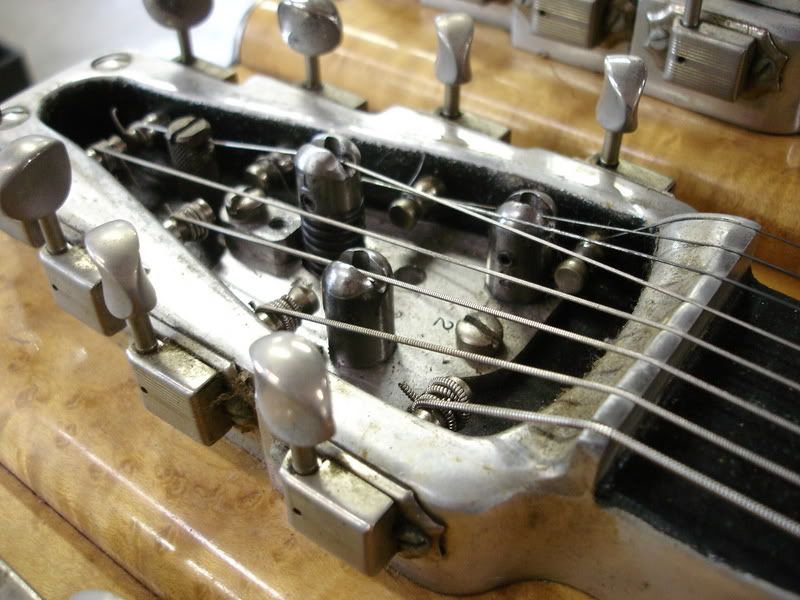 Underside View 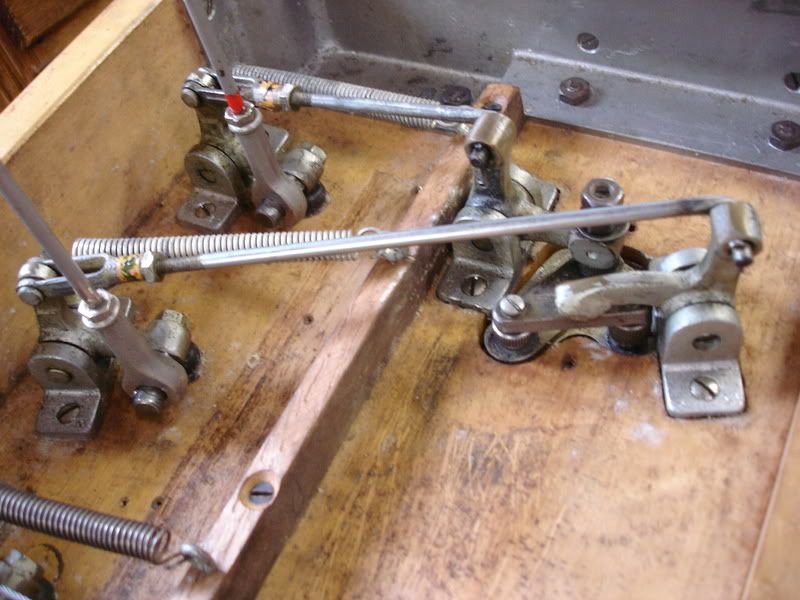 I think the plunger system feels a lot like a modern pedal mechanism. It plays really smooth and believe it or not really stays in tune. It was discontinued because of the fact that you could only get about three tone changes on a neck and you would have to send the guitar back to Bigsby to have your setup altered. TC |
|
Fred Bova Member From: Montrose, California, USA |
The Plunger! Just what I thought! I drew up the same style pitch changer a long, long, time ago, ( late '60's) after tinkering with the idea of adding a pull on an old Rickenbacker Lap Steel. Nothing like reinventing the wheel. Pushing UP relieves the angle of the string over the bridge so it lessens the possibility of breaking strings when the string tension increases. But as you tune the string with the tuning machines the wrap on the post can change the height and angle of the string coming off the post slightly, in theory affecting the amount of pitch shift ever so slightly. In practice it most likely does not matter at all, but having a fixed guide between the Tuning peg and the plunger makes sense. The only real issue is leverage amount and pedal stop so that it feels smooth and easy. For a simple Raise only setup this still is a very valid solution. As far as early designs go,I also always liked the idea of having the changer on the other side of the Tone Bar. The Tone Bar and Left Hand help to dampen any mechanical chatter from the changer from getting into the pickup. |
|
Jussi Huhtakangas Member From: Helsinki, Finland |
Bigsby also used another style keyhead changer; a tuner was attached to a metal "finger" on the outer side of the keyhead. The finger went through the top and was pulled with a cable, so the whole tuning machine rocks back and forth when the pedal is pressed. The amount of raise was adjusted with a little screw on top of the key head. I have one of these on my guitar, raising the fourth string a whole tone. The same string is lowered a half tone with a bridge changer finger. TC, thanks for the pics, those are the best shots of a plunger style changer I've seen. I guess those would be like what were on Speedy's guitar. |
|
T. C. Furlong Member From: Vernon Hills, Illinois, USA |
Jussi, I took those shots because Fred asked about the plunger. My little Sony camera does pretty well. It might not be apparent in the picture but the outer two are a half tone raise on unison strings on one pedal. The other pedal is a single string lower (the middle plunger) I'd really like to see a picture of the rocking keyhead tone changer. If you can send one or two, I'll post them here. Also, do you know what years the rocking keyhead was used? |
|
Mike Black Member From: New Mexico, USA |
TC, mind giving out the serial # of that steel? |
|
T. C. Furlong Member From: Vernon Hills, Illinois, USA |
Mike, It's a June 1952 T-8. TC |
|
Lee Jeffriess Member From: Yucca Valley California |
Jussi, does your T8, have those tuning key changers?,. Jw, has them on his Mack Thomas guitar and, he told me they were done by Johnny Fry, who I guess did mods for Bigsbys ie roller nuts etc. Lee Im sorry,I should have read your post, more carefully. [This message was edited by Lee Jeffriess on 25 October 2006 at 06:22 PM.] |
|
James Pennebaker Member From: Mt. Juliet, TN |
Because I am both curious and fascinated, what is the signifigance of the number "2" stamped into the top plate of the "plunger" mechanism. Does anyone know? JP |
|
T. C. Furlong Member From: Vernon Hills, Illinois, USA |
Hi James, I happen to know. The number 2 that is visible in the picture indicates neck # 2. There are also two other number 2's stamped on that plate that are not visible in the photo. There is one next to each plunger and they indicate which pedal actuates them. So the other single lower plunger has a 1 stamped by it(also not visible in the photo) because it is actuated by pedal 1. If you are still curious and fascinated, I could take a photo that shows all the numbers. I too think that the systems that Paul Bigsby had in place for identifying parts, their function and location are pretty fascinating. And he was thinking this up as he went because he was the first. TC |
|
Jussi Huhtakangas Member From: Helsinki, Finland |
Yeah Lee, there's one on mine, operating on the mid neck keyhead. It's definately a Bigsby made and not a mod, I just emailed some old pics to TC, hopefully they're clear enough to be posted here. I guess Bigsby used this type of changer whenever a customer asked for a lower and raise on the same string, like on my guitar which is a -63. Doyle Boyett guitar has one too and it's a -55. [This message was edited by Jussi Huhtakangas on 25 October 2006 at 10:46 PM.] |
|
T. C. Furlong Member From: Vernon Hills, Illinois, USA |
Let's see if this is clear enough to see the rocking tuning key on Jussi's guitar. 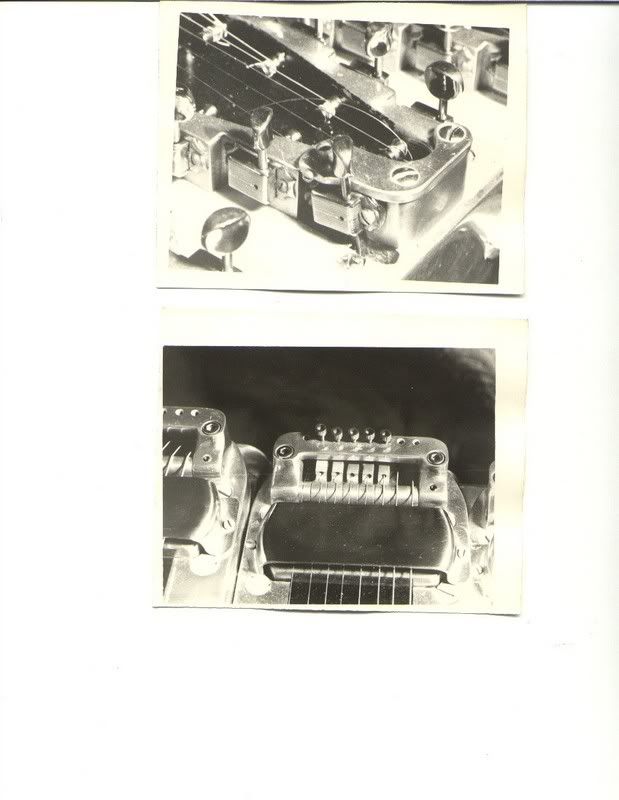 TC |
|
T. C. Furlong Member From: Vernon Hills, Illinois, USA |
These photos of Jussi's guitar are especially interesting because they were taken when the guitar was new. Wow, the maple on the front neck is fantastic.  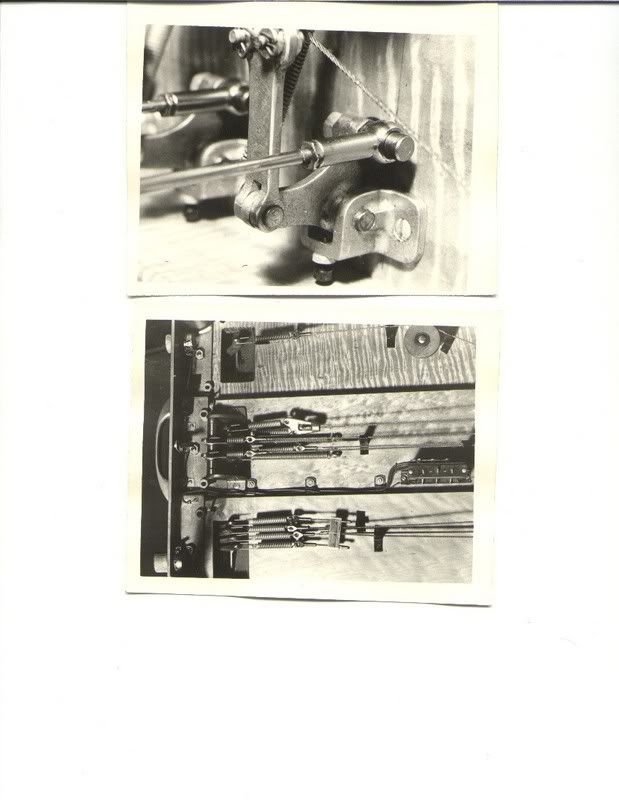 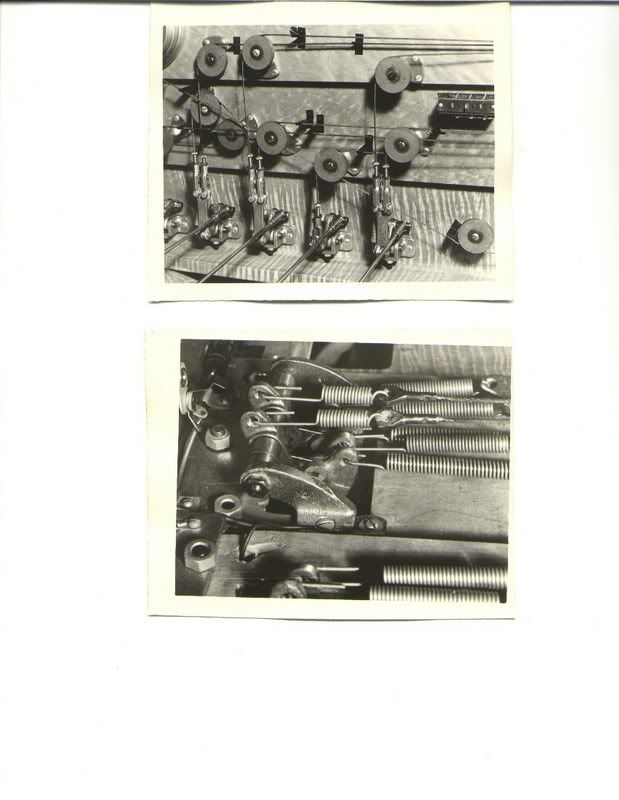 Pretty cool TC |
|
chas smith Member From: Encino, CA, USA |
Good shot of the lowering mechanism which replaced the original spring actuated lever that pulled the string up to pitch. The pedal would then release the tension on the spring and the string would lower. Like holding a pedal down and then lifting your foot off of it. You'll notice the pulleys that came from the airplanes, of the times. Bigsby used to frequent the Lockheed surplus yard. |
This topic is 3 pages long: 1 2 3 All times are Pacific (US) | next newest topic | next oldest topic |
 |
|
Contact Us | The Pedal Steel Pages
Note: Messages not explicitly copyrighted are in the Public Domain.
Powered by Infopop www.infopop.com © 2000
Ultimate Bulletin Board 5.46